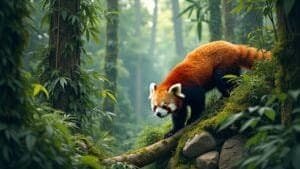Red pandas, native to the mountainous regions of Asia, inhabit a unique range of geographic zones spanning the Eastern Himalayas and parts of southwestern China. So, what are the specific geographic regions where red pandas can be found? Their fragmented range extends across Nepal, India, Bhutan, China, and Myanmar, each offering the cool, temperate forests that red pandas rely on
These elusive mammals prefer high-altitude habitats covered with dense bamboo understory and towering conifers, creating the ideal environment for their arboreal lifestyle. In this article, we’ll explore the precise regions and elevations where red pandas live, examine their forest and climate preferences, and investigate the extent of habitat fragmentation impacting their survival
Geographic Distribution of Red Pandas in Asia

Red pandas inhabit a very specific and fragmented region of Asia, distributed along the forested slopes of the Eastern Himalayas and into parts of southwestern China. Their distribution is largely dictated by altitude, forest composition, and climate, with a preference for cool, temperate broadleaved forests rich in bamboo. Because of their sensitivity to habitat disturbance, red pandas are only found in isolated pockets within these regions, making their geographic spread both unique and ecologically significant
Understanding where red pandas live is essential for developing accurate conservation strategies, especially in the face of ongoing deforestation and fragmentation. This section breaks down the specific national regions where red pandas are found, highlighting their presence in Nepal, India, and Bhutan—the three main countries representing the core of their Himalayan range
Red Panda Range in Nepal
Nepal marks the westernmost extent of the red panda’s range and plays a vital role in its global conservation. Red pandas in Nepal are found primarily in the eastern and central Himalayan regions, within temperate forests ranging between 6,560 and 15,750 feet. These animals prefer secluded habitats within high-elevation forests dominated by fir, oak, and rhododendron trees, underlain by dense thickets of Himalayan bamboo, which forms the bulk of their diet
According to Bista et al. (2021) in a landmark study published in PLOS ONE, red pandas have been confirmed in 24 districts across Nepal. These include key conservation areas such as Langtang National Park, Sagarmatha National Park, Makalu Barun National Park, and the Kanchenjunga Conservation Area. Together, these protected zones represent around 5,330 to 9,270 square miles of potential habitat. Notably, camera trap data and fecal DNA analysis have verified the presence of genetically distinct populations, highlighting the importance of habitat corridors to maintain gene flow
The Nepalese government, through the Department of National Parks and Wildlife Conservation (DNPWC), has developed a Red Panda Conservation Action Plan (2018–2022), which includes strategies for managing forest habitat, involving local communities in conservation, and addressing human-wildlife conflict. These measures are supported by non-governmental organizations like the Red Panda Network, which also promote eco-tourism and sustainable livelihood programs to reduce pressure on panda habitats
For a deeper understanding of Nepal’s habitat conditions and conservation efforts, this WWF article on red panda habitats provides valuable complementary insights
Red Panda Habitats in India
In India, red pandas are predominantly found in the Eastern Himalayan regions, where the climate and vegetation closely mirror those of Nepal and Bhutan. Their primary range includes the state of Sikkim, the Darjeeling district of West Bengal, and several districts of Arunachal Pradesh. These regions host moist temperate forests at altitudes between 6,000 and 13,000 feet, particularly on north-facing slopes with abundant bamboo and mature trees offering nesting and resting sites
A 2021 report by the Wildlife Institute of India and the Zoological Survey of India identified several forest divisions and wildlife sanctuaries supporting red panda populations. Key habitats include the Khangchendzonga National Park in Sikkim and Singalila National Park in West Bengal. Arunachal Pradesh, with its vast and largely unexplored forest cover, is believed to host a significant but poorly documented population
India’s red panda population is listed as Endangered under Schedule I of the Wildlife Protection Act of 1972. However, unlike Nepal, there is no dedicated nationwide conservation strategy solely for red pandas. The Red Panda Survival Blueprint – India (2021), published by the Zoological Society of London’s EDGE program, provides a conservation roadmap, emphasizing the need for habitat mapping, community engagement, and field-based population studies
These fragmented habitats face increasing pressure from deforestation, cattle grazing, and infrastructure development. Still, efforts to expand protected areas and improve ecological connectivity are underway in regions like Sikkim, where red pandas serve as a flagship species for forest conservation
Red Panda Presence Across Bhutan
Bhutan serves as a central zone in the red panda’s Himalayan range, with a continuous belt of temperate forests that provide both connectivity and protection. Red pandas in Bhutan are found at elevations between 4,920 and 14,100 feet, occupying old-growth forests composed of hemlock, fir, birch, and rhododendron, all layered with dense bamboo undergrowth
The National Red Panda Survey 2018–2019, conducted by the Ugyen Wangchuck Institute for Conservation and Environmental Research (UWICER) and the Department of Forests and Park Services, estimated a minimum population of 302 individuals. Their presence spans across 19 of Bhutan’s 20 districts, making the species one of the most widely distributed mammals in the country. Protected areas like Jigme Dorji National Park and Wangchuck Centennial Park are key strongholds
Bhutan’s conservation strategy is deeply rooted in its constitutional mandate to maintain at least 60% forest cover. Its network of biological corridors connects red panda habitats across elevation gradients, facilitating migration and genetic exchange. Community-based conservation efforts, such as forest management groups and ecotourism initiatives, have further contributed to safeguarding red panda populations
As noted in the San Diego Zoo’s red panda distribution fact sheet, Bhutan’s integration of conservation science and national policy offers a valuable model for other Himalayan countries
Red Pandas in China and Myanmar

Beyond the Himalayan core of Nepal, India, and Bhutan, red pandas also extend eastward into China and southeast into Myanmar. These areas host genetically distinct populations and present different ecological contexts, forest types, and conservation challenges. In China, red pandas are mainly found in the southwestern provinces, occupying montane forests with high bamboo density. In contrast, Myanmar holds one of the least-studied red panda populations, primarily restricted to the northern mountainous frontier
Despite being part of the same species complex, the red pandas in these regions have adapted to local conditions, contributing to the overall genetic and ecological diversity of the species. Understanding their distribution in these two countries is essential, particularly as habitat loss and fragmentation continue to threaten isolated populations
Provinces and Forest Types in China
China is home to both recognized species of red panda—Ailurus fulgens (the Himalayan red panda) and Ailurus styani (the Chinese red panda). The Chinese red panda, which is genetically and morphologically distinct, is found mainly in Sichuan and Yunnan provinces, as well as the easternmost parts of Tibet. These regions are characterized by montane mixed forests that include conifers such as fir and spruce, deciduous trees like birch, and a dense understory of bamboo, which is essential to the red panda’s diet
According to a 2020 study by Hu et al. published in Global Ecology and Conservation, Sichuan Province contains the largest share of China’s red panda population, particularly within the Qionglai, Minshan, and Liangshan mountain ranges. Yunnan Province hosts smaller, more fragmented populations primarily in the Gaoligong and Hengduan Mountains. These regions fall within the Hengduan Mountains biodiversity hotspot, which is one of the most species-rich temperate forest areas globally
Red pandas in China typically inhabit altitudes ranging from 7,870 to 12,800 feet. The forests in these elevations offer a cool, moist climate that supports a high density of Fargesia bamboo species—one of the red panda’s primary food sources. However, infrastructure development, such as roads and hydropower projects, has caused increasing habitat fragmentation. As a response, several nature reserves have been established, including Wolong National Nature Reserve and Gaoligongshan National Nature Reserve
Although national efforts exist to protect red pandas in China under the Wild Animal Protection Law (Class II protected species), more coordinated strategies are needed. Conservationists are calling for broader ecological corridor development and transboundary cooperation, particularly with Myanmar and India, to ensure long-term population viability
This topic is explored further in the WWF article on red panda habitats, which highlights China’s key role in red panda conservation
Red Panda Zones in Northern Myanmar
Myanmar represents the southernmost limit of red panda distribution. Their presence is restricted to the far northern regions along the border with China, particularly in areas around Mount Imawbum in Kachin State. These high-elevation forests range from approximately 7,200 to 13,000 feet and are part of the Eastern Himalayan and Indo-Burma biodiversity hotspots. Red pandas here are believed to belong to the Ailurus styani species and may even represent a unique subpopulation due to their geographical isolation
A 2021 report by Harding et al. in Oryx – The International Journal of Conservation provided some of the first reliable evidence of red pandas in Myanmar using camera traps and community surveys. The forests they inhabit are similar to those in Yunnan Province, dominated by oak, rhododendron, fir, and bamboo undergrowth. However, unlike China, Myanmar’s red panda populations are found outside formal protected areas, increasing their vulnerability to poaching and habitat degradation
One of the key conservation challenges in Myanmar is the limited ecological data and the lack of formal management plans. Much of the region is controlled by local and indigenous communities, and conservation must involve partnerships that respect traditional land use. However, recent proposals to create the Imawbum National Park could protect key habitat zones for red pandas and other endangered species such as the takin and clouded leopard
Efforts by international NGOs, including Fauna & Flora International and Rainforest Trust, are working to establish baseline population data and promote conservation awareness among local stakeholders. The integration of indigenous knowledge and scientific research could play a major role in protecting red pandas in this remote corner of their range
For a technical overview of Myanmar’s red panda zones, refer to the San Diego Zoo’s detailed red panda distribution resource, which discusses the regional fragmentation and ongoing habitat pressures
Ecological Characteristics and Habitat Preferences

Red pandas are highly specialized mammals that depend on very particular ecological conditions to thrive. These conditions are primarily dictated by elevation, vegetation structure, climate, and forest integrity. Unlike generalist species, red pandas exhibit strong fidelity to specific forest types, especially those with dense bamboo undergrowth and tree canopy cover that provides shelter and escape from predators
Their reliance on stable, cool temperatures and specific food sources means that even minor environmental disruptions can have significant impacts. This section delves into the core ecological elements that shape red panda habitat preferences, including their altitudinal range, favored forest compositions, and the impact of fragmentation on their distribution across Asia
Preferred Elevation and Forest Types
Red pandas inhabit temperate and subalpine forests typically located at elevations between 6,560 and 15,750 feet, although regional variation exists. In Nepal and India, they are commonly observed between 6,500 and 13,000 feet, while in Bhutan and China, they can be found up to nearly 15,000 feet. These altitudinal zones provide a cooler, stable microclimate essential for red panda thermoregulation and their bamboo-based diet
The preferred forest types are generally classified into temperate broadleaved or mixed broadleaved-coniferous forests. In Bhutan and northeastern India, forests dominated by oak (Quercus spp.), fir (Abies spp.), and rhododendron (Rhododendron spp.) are common habitats. These forests often contain moss-covered old-growth trees with hollows used by red pandas for denning and nesting
In southwestern China, particularly in Sichuan and Yunnan, red pandas are associated with coniferous forests containing spruce (Picea spp.) and fir, interspersed with deciduous trees and an understory rich in bamboo species like Fargesia robusta and Yushania spp.. These bamboo varieties are not just dietary staples but also critical for juvenile cover and foraging pathways
Scientific studies, such as those by Wei et al. (1999) in the Journal of Mammalogy, have shown that red pandas are more active in forest patches with at least 70% canopy cover and steep slopes, which offer both concealment and arboreal access. Tree connectivity is crucial, as red pandas are arboreal and depend on branches to move through the forest without descending to the ground, where they are more vulnerable
Climate also plays a central role. The ideal temperature range for red pandas is between 50°F and 95°F. Outside of these thresholds, metabolic stress can occur, particularly in fragmented habitats without dense vegetative cover. Consistent rainfall and minimal seasonal variation are preferred, as bamboo die-offs due to drought or frost can lead to localized starvation events
Further insights into habitat preferences and vegetation dynamics can be found in this WWF resource detailing red panda ecology, which provides a summary of ongoing habitat monitoring efforts
Vegetation and Climatic Conditions
The defining vegetation feature of red panda habitats is bamboo. Bamboo constitutes more than 85% of their diet, although they are technically carnivores by taxonomic classification. They consume young bamboo leaves and shoots from species like Arundinaria, Fargesia, and Thamnocalamus, which grow profusely in mid-montane regions
However, bamboo is notoriously sensitive to environmental changes. It has irregular flowering cycles, after which it dies, leading to periodic food shortages. Studies from the Eastern Himalayas have shown that after a regional bamboo die-off, red pandas may abandon territories, especially if alternate food sources are unavailable. They occasionally supplement their diet with berries, bird eggs, and insects, but none of these are sufficient to sustain long-term populations
Tree species in red panda forests also contribute to habitat quality. For instance, old-growth trees with cavities are used for maternal dens. Mosses, lichens, and epiphytes on tree trunks add humidity and regulate local temperatures. Forests with mixed-age tree stands offer the best structural diversity, which is essential for nesting, foraging, and predator avoidance
Climatically, red panda zones experience annual precipitation ranging from 30 to 80 inches, mostly during the monsoon and pre-winter seasons. Snow cover is common above 10,000 feet and is tolerated by red pandas, but unseasonal snowfalls can restrict access to bamboo and increase thermoregulation demands
Temperature stability is essential. A study by Glatston et al. (2015) published in Biodiversity and Conservation emphasized that even a 1.5°C rise in mean annual temperature could reduce suitable red panda habitat by up to 30% across their range by 2050 if conservation measures are not enhanced
Fragmentation of Red Panda Distribution
Red panda distribution is heavily fragmented, primarily due to habitat loss, infrastructure development, and changing land use practices. Fragmentation leads to isolated populations, often confined to forest islands surrounded by agriculture, roads, and human settlements. This isolation results in reduced gene flow, increased inbreeding, and higher extinction risk
In a pivotal study by Thapa et al. (2018) published in Scientific Reports, habitat suitability models revealed that less than 25% of the red panda’s historical range remains ecologically viable due to fragmentation. The study also mapped major gaps between populations in Nepal, Sikkim, and western Arunachal Pradesh, where natural forest corridors have been degraded
Road construction through red panda habitats in the Eastern Himalayas and southwestern China is a significant concern. Roads not only physically divide habitats but also increase human access, leading to poaching and disturbance. For example, in the Gaoligong Mountains of Yunnan, camera traps recorded a 35% decrease in red panda sightings after a nearby highway expansion in 2015
Other contributing factors include forest fires, illegal logging, and grazing by livestock, which destroy bamboo regeneration cycles. Transboundary conservation approaches, such as the Kangchenjunga Landscape Initiative (KLI) involving Nepal, Bhutan, and India, aim to restore ecological corridors and connect fragmented populations
These topics are further detailed in the San Diego Zoo’s red panda distribution guide, which provides a breakdown of fragmentation patterns and associated threats












